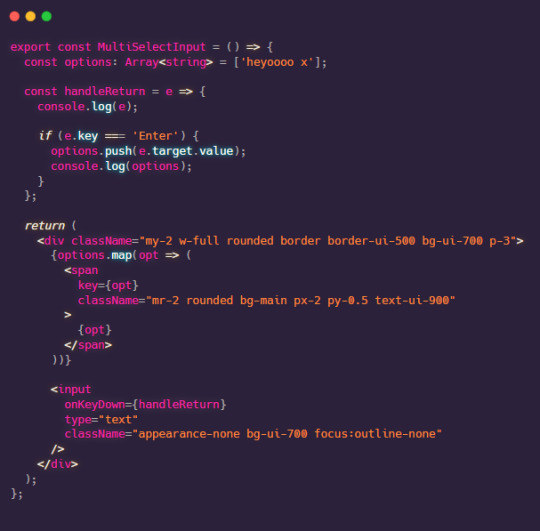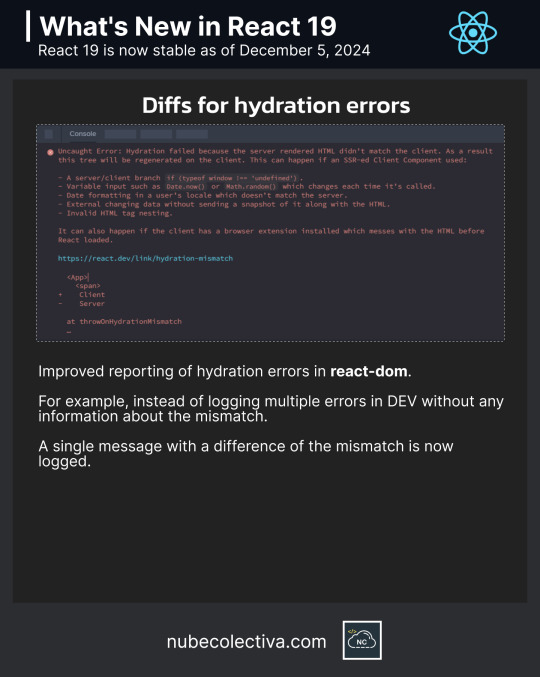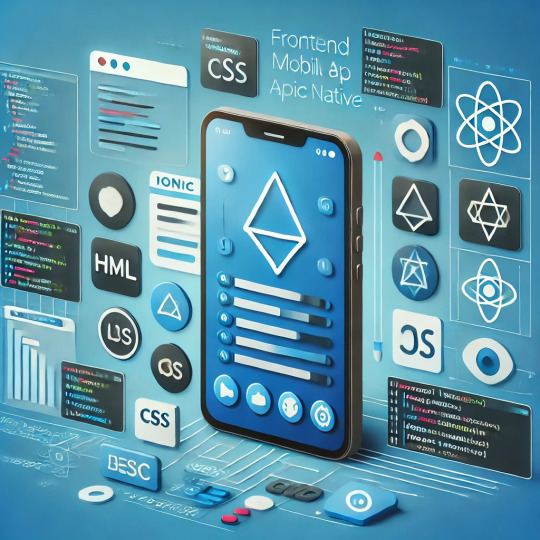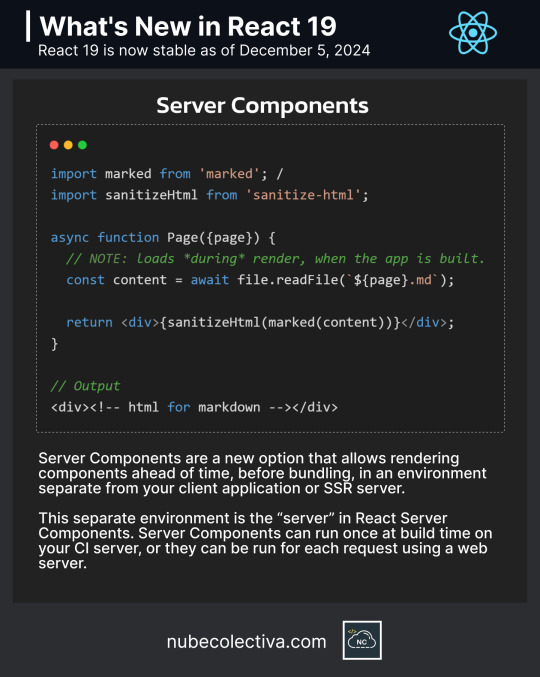#frontend react developer
Explore tagged Tumblr posts
Text
#phpexpertise#react#react development#react developer#frontend developer#react js#react native#react interview questions#react js tutorial#react tutorial#react js interview questions#react bootstrap#frontend react#frontend react developer#frontend react interview questions#senior frontend react interview questions#react hooks interview questions#react hooks#react lifecycle methods#state vs props#storybook#components
1 note
·
View note
Text


Not working at the desk, but not working in bed either, so win!
I reallyyy need to start revising for exams, but this PTI/PTR project seems endless. I'm actually enjoying working on the frontend, so I'm spending a lot of time on it, because I want it to look nice and professional dammit.
#uni#life#studyblr#study#academia#codeblr#information technologies#coding#books#bookblr#frontend development#react
115 notes
·
View notes
Text
let today = new Date("12 December 2023");
Hey coders!
The past couple of months I've been a frontend developer intern at an e-sports company and it's been so amazing! I am realizing that yeah, this is exactly what I want to do! I feel super lucky.
Anyway, today, and for the past like week, I have been struggling with implementing the multiselect from react-select in a form we are building in my team. It's a very complicated field, where you can choose from different lists, with values that need to be replaced and disabled depending on which list you are choosing from and what has already been chosen, so just getting the logic right was tough.
Today I got it working, only to realize I can't style it without all the functionality breaking. Feeling like I've tried everything, I was like: you know what? Fuck it, I'm just gonna make my own. Sooo here I am!
This is the inspo (from react-select):

And this is how far I've gotten(using our on-brand styles):

Anddd here's my (non funcitoning) code:

To break it down:
I have a div that contains a span (which will be rendered from an array of options, to be the yellow chip) and an invisible input field
The div is styled to look like an input field, but in reality it's just a div with spans and an invisible input field following the span (lol special thanks to this stack overflow thread)
When the user types, I am listening to what keys they are pressing with a function I am currently calling handleReturn
If the pressed key is "Enter", I will push the current value of the field to the options array
But! This does not do anything at the moment, since the options array does not tell the component to update itself in any way to display the newly added value! For that, I need to make the options array be a state using the useState() hook from React!
When a state is changed, react's useState can tell, and it will rerender (=update) the component, and then my new value will (...should) be shown as well, since it will be using the new array with new values!
Stay tuned for updates(:
#codeblr#react.js#react#reactjs#frontend#frontend developer#web development#compsci#stem#woman in stem#coding#programming#css#html#javascript#js#software engineering#typescript
17 notes
·
View notes
Text
Full-Stack Web Development with React and Node.js

In today's fast-evolving digital landscape, full-stack web development has become essential for businesses looking to build dynamic, scalable, and high-performance applications. React.js for frontend and Node.js for backend form a powerful combination, enabling seamless development and enhanced user experiences. This blog explores the concept of full-stack development, the advantages of React.js for frontend, and the benefits of Node.js for backend, highlighting why this technology stack is the preferred choice for developers and enterprises.
Definition of Full-Stack Development
Full-stack web development refers to the practice of developing both the frontend (client-side) and backend (server-side) of a web application. A full-stack developer is proficient in:
Frontend development – Building interactive and responsive user interfaces using frameworks like React.js.
Backend development – Managing business logic, databases, and API interactions with Node.js.
Database management – Handling data storage and retrieval using MongoDB, MySQL, or PostgreSQL.
Server and API handling – Facilitating seamless data communication between frontend and backend.
This comprehensive approach ensures businesses receive end-to-end web solutions with improved efficiency and scalability.
Why Choose React.js for Frontend Development?
React.js is a widely used frontend JavaScript library known for its performance, flexibility, and scalability. Businesses prefer React.js for:
✅ Component-Based Architecture
React.js enables developers to build reusable UI components, simplifying the development process and improving maintainability.
✅ Optimized Performance with Virtual DOM
The Virtual DOM (VDOM) in React.js updates only necessary components instead of re-rendering the entire page, ensuring faster load times and smoother interactions.
✅ SEO-Friendly Web Applications
With server-side rendering (SSR) capabilities through frameworks like Next.js, React.js improves SEO rankings, enhancing website visibility on search engines.
✅ Robust Ecosystem and Community Support
A vast ecosystem of tools, libraries, and third-party integrations—including Redux, React Router, and Material UI - enables faster and more efficient development.
Why Use Node.js for Backend Development?
Node.js is an efficient, event-driven JavaScript runtime that powers high-performance backend systems. Businesses opt for Node.js due to:
✅ Single Language for Full-Stack Development
Using JavaScript for both frontend (React.js) and backend (Node.js) eliminates language barriers, simplifying development and reducing costs.
✅ Non-Blocking, Asynchronous Architecture
Node.js operates on an event-driven, non-blocking model, allowing it to handle multiple requests simultaneously - ideal for real-time applications.
✅ Scalability and Microservices Architecture
Node.js is designed for scalability, making it an excellent choice for enterprise applications that require dynamic scaling.
✅ Seamless API Development
Developers can create RESTful APIs and GraphQL APIs to facilitate efficient data exchange between the frontend and backend.
Conclusion
The combination of React.js and Node.js has transformed full-stack web development, providing high performance, scalability, and cost-effectiveness. Whether you are developing an e-commerce platform, SaaS solution, or enterprise web application, this technology stack ensures speed, security, and seamless user experiences.
At VeravalOnline Private Limited, we specialize in full-stack web development using cutting-edge technologies, including React.js, Node.js, MongoDB, and Express.js. Our expert developers craft custom web solutions tailored to meet your business needs, ensuring innovation and efficiency at every stage.
🚀 Looking for professional full-stack development services? Contact VeravalOnline Private Limited today!
#Full-Stack Web Development#Full-Stack Development with React and Node.js#React.js Development#Node.js Backend Development#Full-Stack Developer#Full-Stack Web Application#React.js for Frontend#Node.js for Backend
0 notes
Text
Mastering JavaScript Interviews in 2025: Top Questions, Answers, and Insider Tips
Are you preparing for JavaScript interviews in 2025? 🚀 This comprehensive guide covers top questions, answers, and insider tips to help you stand out! 💡 Don’t miss it: https://stacksgather.com/articles/mastering-javascript-interviews-in-top-questions-answers-and-insider-tips #JavaScript #TechInterviews #CareerGrowth #stacksgather #awaitsol #awaitsol.com #stacksgahter.com
0 notes
Text
Hydration Error Differences in React 19 !
Diferencias de Errores de Hidratación en React 19 !
🔎 Zoom: https://nubecolectiva.com/comunidad/flyers/hydration-error-differences-in-react-19/

#software development#web development#100daysofcode#devs#developerlife#developers#web developers#worldcode#developers & startups#backenddevelopment#frontendev#frontenddevelopment#frontend developer#female fronted#reactjs#react 19
1 note
·
View note
Text
Frontend Developer React: Yeni Başlayanlar üçün Tövsiyələr
Frontend developer olmaq istəyirsinizsə, React kimi güclü və populyar bir kitabxananı öyrənmək çox vacibdir. React istifadə edərək veb tətbiqləri yaratmaq, həm istifadəçi interfeyslərinin dinamikliyi, həm də optimallığı baxımından böyük üstünlüklər verir. React sahəsində yeni olanlar üçün bəzi tövsiyələr təqdim edirik:
1. HTML, CSS və JavaScript-də Güclü Baza Yaradın
React-i öyrənməyə başlamazdan əvvəl HTML, CSS və JavaScript biliklərinizi gücləndirmək vacibdir. Çünki React bu dillərin üzərində işləyir və əsas anlayışları bilmək React-də uğurlu olmaq üçün vacibdir. JavaScript-də xüsusilə ES6 sintaksisini öyrənmək faydalı olacaq, çünki React çox zaman ES6 xüsusiyyətlərini istifadə edir.

2. React Componentlərini Yaxşı Anlayın
React, komponent əsaslı bir memarlıq üzərində qurulub. Hər bir komponent müstəqil bir istifadəçi interfeysi hissəsini təmsil edir. Bu səbəbdən, komponentləri yaratmağı və onlarla işləməyi yaxşı bilmək lazımdır. Funksional komponentlər və class komponentlər arasındakı fərqi başa düşmək önəmlidir, lakin funksional komponentlər və Hooks müasir React-də daha çox istifadə edilir.
3. State və Props Anlayışını Öyrənin
Frontend Developer React-də komponentlər arasında məlumatların ötürülməsi üçün props, komponent daxilində dəyişən məlumatlar üçün isə state istifadə olunur. Bu iki anlayışın necə işlədiyini dərindən başa düşmək vacibdir, çünki hər bir React tətbiqində məlumat axını ilə işləyəcəksiniz.
4. Hooks İlə Təcrübə Qazanın
React-də useState və useEffect kimi Hooks-lardan istifadə etməyi öyrənin. Hooks, funksional komponentlərdə state idarəetməsi və yan təsirlərin idarə olunması üçün əsas vasitələrdən biridir. Hooks React tətbiqlərinin daha sadə və aydın olmasını təmin edir.
5. Praktiki Layihələr Üzərində İşləyin
React öyrənməyin ən yaxşı yollarından biri praktik layihələr üzərində işləməkdir. Sadə bir todo list tətbiqi ilə başlaya bilərsiniz və tədricən daha mürəkkəb layihələrə keçə bilərsiniz. Bu, həm də portfolionuz üçün yaxşı nümunələr yaratmağınıza kömək edəcək.

6. Component Lifecycle Anlayışını Öyrənin
Komponentlərin həyat dövrü (lifecycle) React-də vacib bir mövzudur. Tətbiqinizin müxtəlif mərhələlərində, məsələn, komponent yüklənəndə və ya yeniləndikdə baş verənləri idarə etmək üçün lifecycle metodlarından istifadə olunur. Funksional komponentlərdə bu proses Hooks vasitəsilə həyata keçirilir.
7. Böyük Məlumatlarla İşləməyi Öyrənin
React tətbiqləri zamanı bir çox məlumatlarla işləmək lazımdır. Bu səbəbdən, məlumatları idarə etmək üçün effektiv üsullar öyrənmək vacibdir. Əgər React layihələrinizdə çoxsaylı komponentlər arasında məlumat axını idarə etməli olsanız, Redux və ya Context API kimi vasitələrdən istifadə edə bilərsiniz.
8. Git və Versiya İdarəetmə Sistemlərindən İstifadə Edin
React layihələrində versiya idarəetməsi əhəmiyyətlidir. Git vasitəsilə kodunuzun fərqli versiyalarını idarə etmək və geri qayıtmaq mümkündür. GitHub kimi platformalarda layihələrinizi paylaşmaq və əməkdaşlıq etmək də sizə təcrübə qazandıracaq.
9. Yeni Texnologiyaları Öyrənməyə A��ıq Olun
React ekosistemi daim inkişaf edir və yeni alətlər və texnologiyalar meydana çıxır. Yeni çərçivələri və kitabxanaları öyrənməkdən çəkinməyin. Next.js, Gatsby, Chakra UI kimi kitabxanalar və alətlər React layihələrinizin daha sürətli və funksional olmasına kömək edəcək.
Yeni başlayanlar üçün React-i öyrənmək vaxt və səbir tələb edir, lakin davamlı təcrübə və öyrənmə ilə frontend development sahəsində uğurlu olmaq mümkündür.
0 notes
Text
Hire React js Developer
#ReactJS Developer#Hire React Developer#React Frontend Developer#React Engineer#Frontend Development#JavaScript Developer#Web Developer#Frontend Engineer#React Programmer#UI/UX Developer#React.js#JavaScript
1 note
·
View note
Text
0 notes
Text
Front End Developer React Training with Placement in Hyderabad.
If you are looking to build a career as a Front End Developer specializing in React and want a program that includes placement support, Hyderabad offers several excellent options. Many training institutes in Hyderabad focus on equipping learners with in-demand React.js skills, which is a leading JavaScript library for building user interfaces.
What to Expect in a React Front-End Developer Course: Comprehensive Curriculum:
Introduction to HTML, CSS, and JavaScript as prerequisites. Deep dive into React.js fundamentals: Components, Props, State, Lifecycle methods, and Hooks. Building Single Page Applications (SPAs) with React Router. Integration with APIs using Axios or Fetch. Managing global state with Redux. Deployment strategies and version control with Git. Real-world Projects: You will be tasked with creating projects that mimic industry-level challenges, such as creating responsive and dynamic web applications. This is critical for building a portfolio to show potential employers.
Placement Assistance: Institutes providing this training often include:
Resume building and mock interview sessions. Direct connections with IT companies in Hyderabad. Job guarantee programs or placement drives with tech companies and startups.
Most of these programs have flexible timings and both online and offline training modes, so you can learn at your own pace while receiving guidance from industry experts. After completing the training, you will be ready for roles like React Front End Developer, UI Developer, or JavaScript Developer.

Websoft Technologies:
Add:#9-16/2, 2nd Floor, KK Arcade Building, Opp: Konark Theatre Lane, Beside Metro Station, Dilsukhnagar, Hyderabad, Pin code: 500 060.
040-24045235 | +91 9392313836
www.websoftts.com
0 notes
Text
Exploring Component-Based Architecture in NextJS
Unlocking the Power of Component-Based Architecture Component-based architecture is a powerful approach in modern web development that allows for modular, reusable, and scalable code. With frameworks like NextJS, developers can leverage the benefits of component-based architecture to build efficient and maintainable web applications. What is Component-Based Architecture? In component-based…
#component-based architecture#component-driven#efficient frontend development#Frontend Development#NextJS#NextJS component-based architecture#React#scalable web development#web development
0 notes
Text
Frontend Development for Mobile Apps with Frameworks like Ionic or React Native

In today's fast-paced digital world, businesses are increasingly seeking efficient ways to build high-quality mobile apps. Frontend development plays a crucial role in creating responsive and user-friendly mobile applications. Two popular frameworks for mobile app frontend development are Ionic and React Native. Both frameworks allow developers to build cross-platform apps, reducing development time and cost. In this article, we’ll explore how these frameworks work and the benefits they offer for mobile app development.
What is Frontend Development in Mobile Apps?
Frontend development focuses on the user interface (UI) and user experience (UX) of an application. For mobile apps, this involves creating interactive elements like buttons, menus, and layouts that users interact with. With the increasing demand for mobile apps, businesses need to deliver seamless user experiences across different platforms, including iOS and Android. This is where frameworks like Ionic and React Native come in.
Why Choose Cross-Platform Frameworks for Mobile App Development?
Building separate apps for iOS and Android can be time-consuming and expensive. Cross-platform frameworks like Ionic and React Native allow developers to write a single codebase that works on both platforms. This not only speeds up the development process but also reduces maintenance efforts. Here are the benefits of using these frameworks:
Cost Efficiency: With a single codebase, companies save money on development and updates.
Faster Development: Developers can launch apps quicker by writing code once and deploying it across platforms.
Consistent UI/UX: Ensures a unified look and feel on both iOS and Android devices.
Ionic Framework for Mobile App Development
Ionic is an open-source framework that uses web technologies like HTML, CSS, and JavaScript to build mobile apps. It's built on top of Angular and integrates well with Apache Cordova, enabling access to native device features like the camera and GPS.
Key Features of Ionic:
Cross-Platform Compatibility: Build apps that run smoothly on both iOS and Android.
Pre-Built UI Components: Ionic offers a wide range of ready-made components, speeding up the design process.
Native Plugin Integration: Access native device functionalities through plugins, without writing native code.
Web View: Apps are rendered in a web view, making it easier for web developers to transition to mobile app development.
Advantages of Ionic:
Perfect for developers familiar with web technologies.
Large community support with extensive documentation.
Fast prototyping for MVP (Minimum Viable Product) development.
React Native for Mobile App Development
React Native, developed by Facebook, is another powerful framework for building cross-platform mobile apps. Unlike Ionic, which uses web technologies, React Native allows developers to write native code for both platforms using JavaScript. This provides better performance compared to web-view-based frameworks.
Key Features of React Native:
Native Components: React Native renders real native components, ensuring faster performance.
Hot Reloading: Developers can instantly see changes without recompiling the entire app.
JavaScript and React: Leverages JavaScript and the popular React library, making it easier for web developers to adopt.
Third-Party Plugins: React Native has a rich ecosystem of third-party plugins for extended functionality.
Advantages of React Native:
Near-native performance for both iOS and Android apps.
Reusable components across platforms.
Large developer community and regular updates from Facebook.
Ionic vs React Native: Which One to Choose?
Choosing between Ionic and React Native depends on the specific needs of your project. Here are some points to consider:
Performance: If performance is critical and you need a near-native feel, React Native is the better option.
Development Speed: For rapid prototyping and building MVPs, Ionic is faster due to its pre-built UI components and web-based architecture.
Familiarity with Technologies: If your team is experienced with Angular, Ionic is an easier choice. If they are more familiar with JavaScript and React, then React Native would be the better option.
The Future of Mobile Frontend Development
The demand for cross-platform mobile apps is growing, and frameworks like Ionic and React Native are at the forefront of this trend. As technology evolves, these frameworks continue to improve, offering better performance, more features, and easier integrations with backend systems. The future of frontend mobile development lies in the ability to create high-performance, cost-effective, and user-friendly apps that work seamlessly across all devices.
Conclusion
Both Ionic and React Native are powerful tools for frontend mobile app development. Choosing the right framework depends on your project’s goals, timeline, and the expertise of your development team. If you're looking to develop a mobile app that offers fast performance, cost efficiency, and a seamless user experience, either of these frameworks can be a great choice. Explore both options and see which fits your needs best for building high-quality mobile apps.
#Frontend mobile app development#Ionic framework for mobile apps#React Native for cross-platform apps#Cross-platform mobile app development#Mobile app frameworks#JavaScript for mobile apps#Ionic vs React Native#Mobile UI/UX development#ahextechnologies#reactnative#ionic
0 notes
Text
React can help you build a responsive and seamless user experience for web development. You can create intuitive user interfaces on a range of development platforms with React, a JavaScript framework that is incredibly adaptable. React is one of those technologies that you can learn and use quickly across many platforms.
0 notes
Text
#dapl#digital aptech#react native#frontenddevelopment#frontend development#front end development#web development services#web developers#web development#web development company
0 notes
Text
Node.js in Web Designing: A Game-Changer

#nodejs#css#html#javascript#reactjs#programming#python#angular#php#webdeveloper#java#webdevelopment#coding#developer#vuejs#jquery#js#programmer#software#webdesign#react#mongodb#laravel#softwaredeveloper#android#code#mysql#coder#webdesigner#frontend
1 note
·
View note
Text
Server Components in React 19 !
Componentes de Servidor en React 19 !
🔎 Zoom: https://nubecolectiva.com/comunidad/flyers/server-components-in-react-19/

#software development#web development#100daysofcode#devs#developerlife#developers#web developers#worldcode#developers & startups#backenddevelopment#frontendev#frontenddevelopment#frontend developer#developer#react 19#reactjs
1 note
·
View note